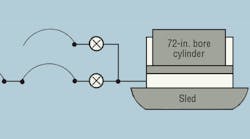The Old Timer of Royal Oak, Mich., was a regular contributor to H&P years before we ever even heard of the internet. But most of his advice is just as useful — and interesting — today.
So rather than leave his wisdom printed on pages archived in our storage room, I pulled out issues from the late 1980s and early 1990s and have been reproducing relevant entries in this blog. Here is my 20th entry, which was originally published in the August 1989 issue:
Water to the Rescue
At one of our aluminum die casting plants, 42-wheeler trucks loaded with molten aluminum in huge kettles entered through the remote North Gate. A heavy-duty concrete roadway provided a path to the plant for these monsters, but every now and then one of the drivers would misread a curve near the gate and run off the pavement. We kept a large Cat tractor on standby to help pull these trucks out, but if they were mired in badly or had blown a tire or two, it was a real race with the clock because the aluminum would harden after about an hour and the expensive load became a total loss.
This was the typical kind of problem that management loved to dump onto the Hydraulics Dept. “We need a portable 80-ton jack for the North Gate area so we can lift the truck beds and slip some railroad ties under the wheels before dragging them out of the mud. Do it cheap because there’s no money for this project.”
A visit to the North Gate revealed—as expected—that no compressed air or hydraulics were available there. Utilities consisted of 110-V electricity for lights and a 2-in water main for the large flower beds that were the plant manager’s pride and joy.
Could we use water pressure to jack up those monster trucks? We learned that water pressure was 60 psi most of the time, 50 psi the rest. To lift 80 tons with 50 psi, we’d need 3200 in.2 of piston area. Wow, a real whopper!
We mounted the cylinder onto a large sled base (another piece of junk) and borrowed a couple of lengths of soft 2-in. fire hose. We teed into the water main at the gate, piped up some hose couplings and three 2-in. gate valves, and we were in business.
The tractor would drag the sled to a mired truck and push it under the low side. A crew then would roll out the hoses, couple them into the system, and turn on the water. The jack extended, the truck lifted, and the crew shoved some ties under the wheels. When they were ready to lower, they dumped the water from the jack in the general vicinity of the flower beds. Then, with an assist from the tractor, the truck was off and running.
This arrangement was not really too unusual when you remember that the original 10th-century hydraulic systems all used straight water. In fact, I carried the concept home where I jack up my car with a garden hose and a scrounged 8-in. bore cylinder.


